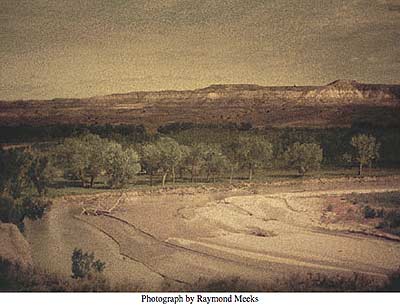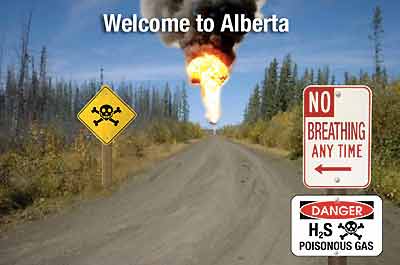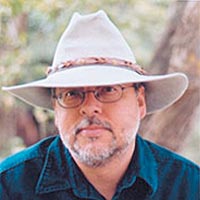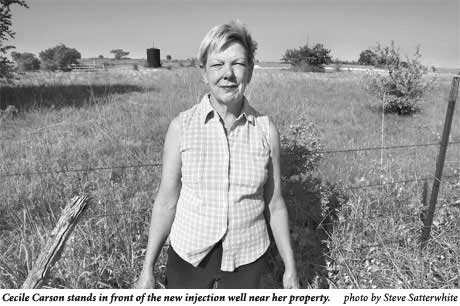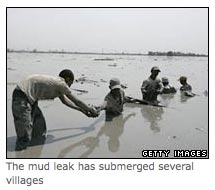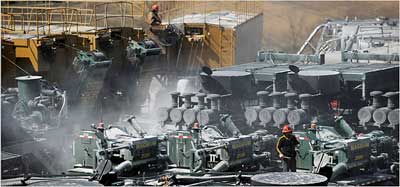Contains the keyword press
Powder Keg
The gas industry has been busy in Wyoming's prairies and grasslands, building thousands of miles of roads and sinking more than 10,000 wells in the past three years. But in the Powder River basin, ranchers are joining environmentalists to try to still the drills.
See: C-Span Book TV Oct. 2, 2004. Bushwacked: Life in George W. Bush's America. Chapter: "Dick, Dubya, and Wyoming Methane." (152)
David Beers. "Tar Sands Expert Nikiforuk to Speak at UBC." The Tyee. 2010-09-09.
Tyee writer-in residence will reveal 'Who Regulates Canada's Oil Patch, and for Whom?'
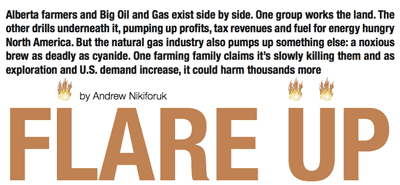
“Sour gas is one of the most dangerous, toxic substances known to man,” he said. “Having a sour gas well 800 metres from your home is like having a child molester an in urban community. You never know when things are going to go wrong.”
Charlie Smith. "Andrew Nikiforuk: EnCana pipeline attacks are not ecoterrorism." Straight.com. 2008-10-17.
You can read another interview with Nikiforuk about his Tyee project here and find his work, so far, here.
See: The Globe and Mail. "Andrew Nikiforuk wins Rachel Carson medal." July 22, 2009.
See: Society of Environmental Journalists.SEJ's Rachel Carson Environment Book Award."
A report on how the Federal Safe Drinking Water was amended by the U.S. Congress in 2005 to exempt hydraulic fracturing from its regulations.
WASHINGTON — Over the last four years, the Bush administration and Vice President Dick Cheney's office have backed a series of measures favoring a drilling technique developed by Halliburton Co., Cheney's former employer.
The technology, known as hydraulic fracturing, boosts gas and oil production and generates $1.5 billion a year for the company, about one-fifth of its energy-related revenue. In recent years, Halliburton and other oil and gas firms have been fighting efforts to regulate the procedure under a statute that protects drinking water supplies.
The 2001 national energy policy report, written under the direction of the vice president's office, cited the value of hydraulic fracturing but didn't mention concerns raised by staff members at the Environmental Protection Agency.
Since then, the administration has taken steps to keep the practice from being regulated under the Safe Drinking Water Act, which Halliburton has said would hurt its business and add needless costs and bureaucratic delays.
An EPA study concluded in June that there was no evidence that hydraulic fracturing posed a threat to drinking water. However, some EPA employees complained about the study internally before its completion, and others have strongly criticized it publicly since its release.
Eyal Press. The Nation. September 23, 2004.
This article appeared in the October 11, 2004 edition of The Nation.
"...Beginning under the Clinton Administration, the federal government pushed to expand production of this comparatively clean-burning fossil fuel, although Clinton also protected millions of acres of public land from drilling.
The Bush Administration, by contrast, has called for removing all "restrictions and impediments" on domestic development, code language for opening dozens of pristine natural habitats to unfettered leasing..."
Jim Robbins. September 10, 2006. New York Times.
It is a strange fight, Montana ranchers say. Raising cattle here in the parched American outback of eastern Montana and Wyoming has always been a battle to find enough water.
Now there is more than enough water, but the wrong kind, they say, and they are fighting to keep it out of the river.
Mark Fix is a family rancher whose cattle operation depends on water from the Tongue River. Mr. Fix diverts about 2,000 gallons per minute of clear water in the summer to transform a dry river bottom into several emerald green fields of alfalfa, an oasis on dry rangeland. Three crops of hay each year enable him to cut it, bale it and feed it to his cattle during the long winter.
“Water means a guaranteed hay crop,” Mr. Fix said.
But the search for a type of natural gas called coal bed methane has come to this part of the world in a big way. The gas is found in subterranean coal, and companies are pumping water out of the coal and stripping the gas mixed with it. Once the gas is out, the huge volumes of water become waste in a region that gets less than 12 inches of rain a year.
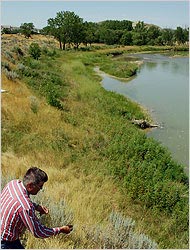
Mark Fix, a cattle rancher in eastern Montana, diverts about 2,000 gallons per minute of Tongue River water in the summer to grow hay for his livestock. But increased sodium in the water could endanger his hayfields.
See: Molly Ivins. (2004) C-Span Book TV Oct. 2, 2004. Bushwacked: Life in George W. Bush's America. Chapter: "Dick, Dubya, and Wyoming Methane." (152)
Cecile Carson's property has an aura of rural homeyness. The neat yard, happy dogs, and blooming flowers along her fence rails suggest a love of place.
She's a high school art teacher who picked a little swath of Wise County near the small town of Decatur, about 35 miles north of Fort Worth, to settle down. She lived in a travel trailer for the first three years while she designed and built her home. The place is well thought out—its colors blend with the surrounding landscape of green, rolling hills.
It took Carson 10 years to get to this point. But it took the Railroad Commission of Texas about 45 seconds to put it all in jeopardy. On April 11, at an administrative hearing in Austin, it took less than a minute for a public reading of Carson's and her neighbor's protests against the placement of an oilfield waste injection well just a few hundred feet from their property.
Then the three commissioners immediately voted "denied" without discussion...
...Part of the commission's enforcement problem is a lack of effective penalties. After the commission field staff goes through an elaborate protocol of voluntary compliance with an offending operator, the inspector must dot every "i" and cross every "t" in order to file a legal enforcement package that will, at most, result in a fine of between $500 and $3,500.
BBC. January 24, 2007. A mud flow that has displaced thousands of Indonesians was most probably caused by gas drilling, scientists say.
See: Davies, R. J, R. E Swarbrick, R. J Evans, and M. Huuse. 2007. "Birth of a mud volcano: East Java, 29 May 2006." GSA Today 17, no. 2: 4–9.
See below: Hardiyan Digwiyono. (2006). "Children in the Hot Mud Volcanoes". YouTube.
Watch the related videos that follow this one minute film.
Tempers and dangers are ramping up in the gas field we call home.
"Ah, for the good old days in the springtime of the Barnett Shale boom, when the words “royalty check” were enough to get homeowners to sign away their mineral rights and everyone still thought the 3 a.m. screech of drilling equipment was just the sound of money.
When no one thought that wells could possibly send property values tumbling or turn well water brown, before drilling sites and pipelines had started leaking, burping, and blowing up. When there were no neighborhood groups ganging up to demand higher royalties, tighter controls, or — say it ain’t so — trying to stop wells outright...
...Even gas company officials admit that the boom is drawing more and more inexperienced workers to drilling sites. “Veteran crews are being divided up and filled with people who have no experience whatsoever working rigs, laying pipe, and such,” said pipeline company manager Jerry Holsworth.
And so accidents are increasing. At least two people have been killed in Barnett Shale operations thus far.
Gas could be an economic bonanza for individuals and state government.
A frenzied land rush that is already making some landowners rich and infuriating others who leased their land too early for too little.
Thousands of gas wells drilled upstate, many using more than a million gallons of water laced with dozens of toxic chemicals like hydrochloric acid, benzene, toluene and xylene, to fracture shale thousands of feet underground to release the gas trapped within it.
Enormous questions about industrial noise, truck traffic and new roads gouged into hills; about holding ponds created to trap the polluted and spent water used in drilling; about land reclamation; about the effects on the New York watershed...
Federal energy legislation promoted by the Bush administration in 2005 exempted the gas industry from many clean-air and clean-water regulations.
Albany, where the state recently passed legislation that made it easier for the Department of Environmental Conservation to issue permits for horizontal drilling, may not be a great bet to do any better than the federal government.
HUGHESVILLE, Pa. — At first, Raymond Gregoire did not want to listen to the raspy voice on his answering machine offering him money for rights to drill on his land. They want to ruin my land, he thought. But he called back anyway a week later to hear more.
By the end of February, he had a contract in hand for $62,000, and he pulled together a group of 75 neighbors who signed $3 million in deals.
“It’s a modern-day gold rush in our own backyard,” Mr. Gregoire said.
Kalim A. Bhatti for The New York Times.Property owners at a seminar in Clarks Summit, Pa., on negotiating with gas lease companies.
Jeff Swensen for The New York Times.Fracture drilling workers run machinery on a farm outside of Pittsburgh. Companies are risking big money on rural Pennsylvania, producing billions of dollars' worth of natural gas.





